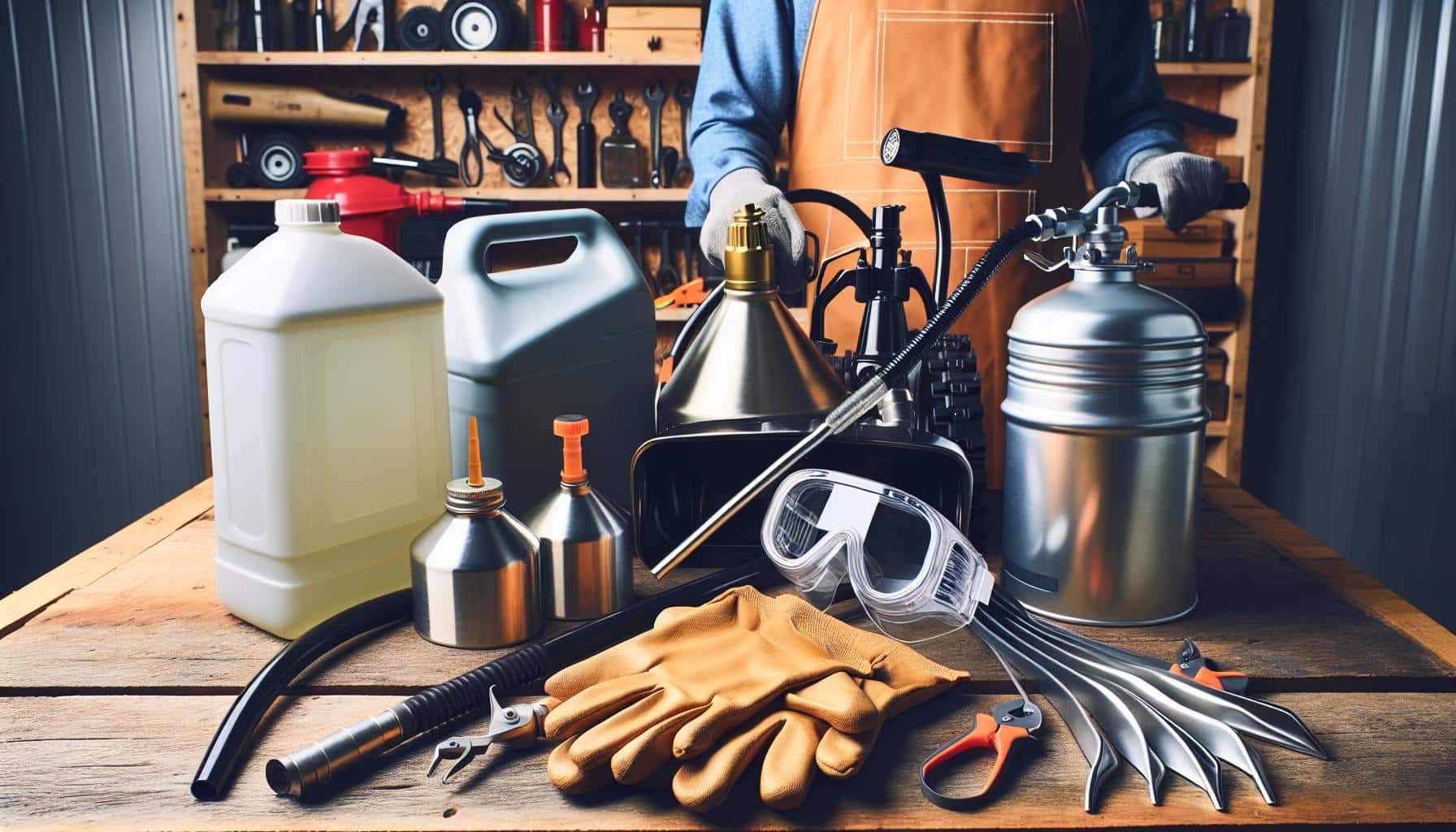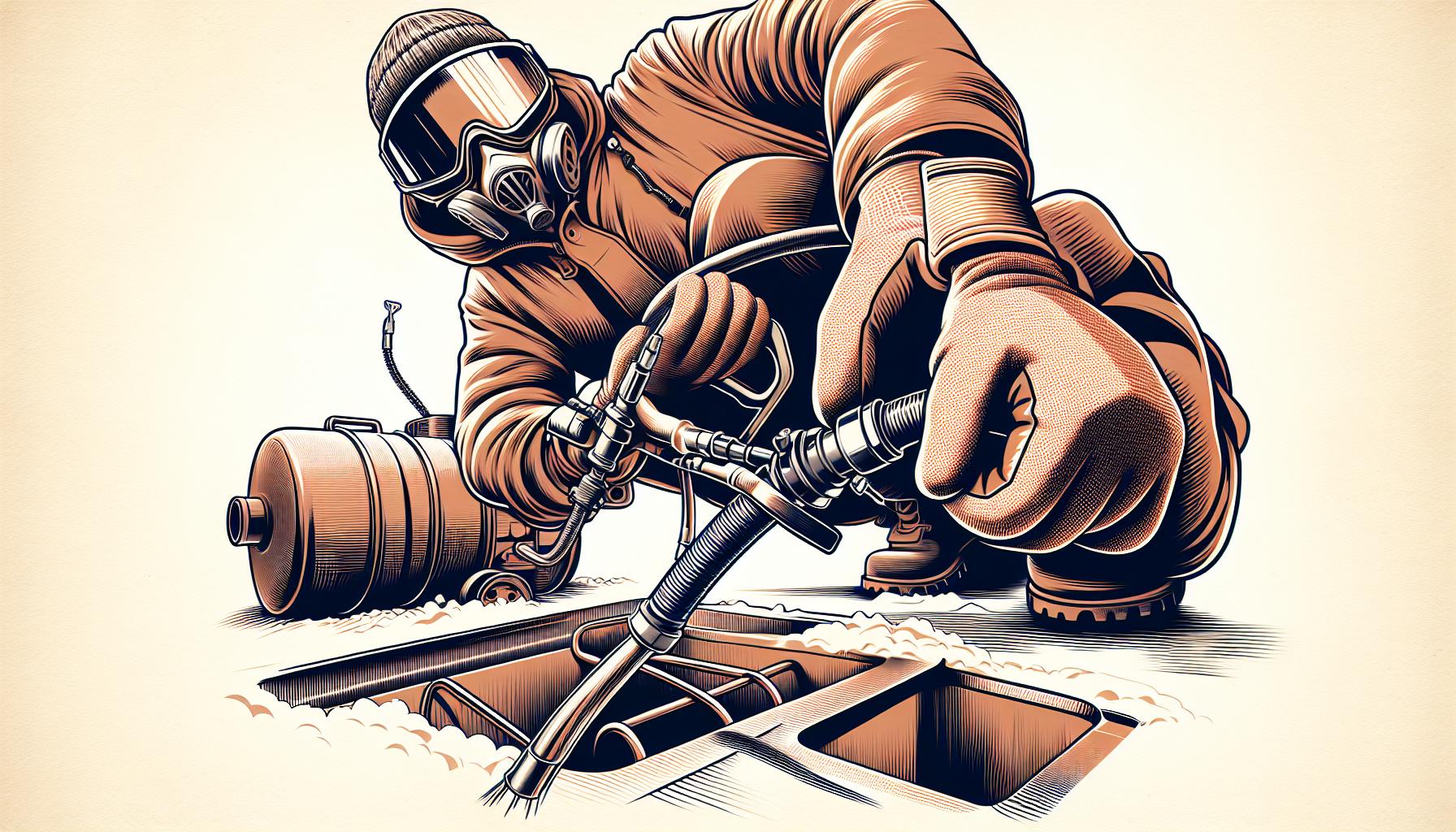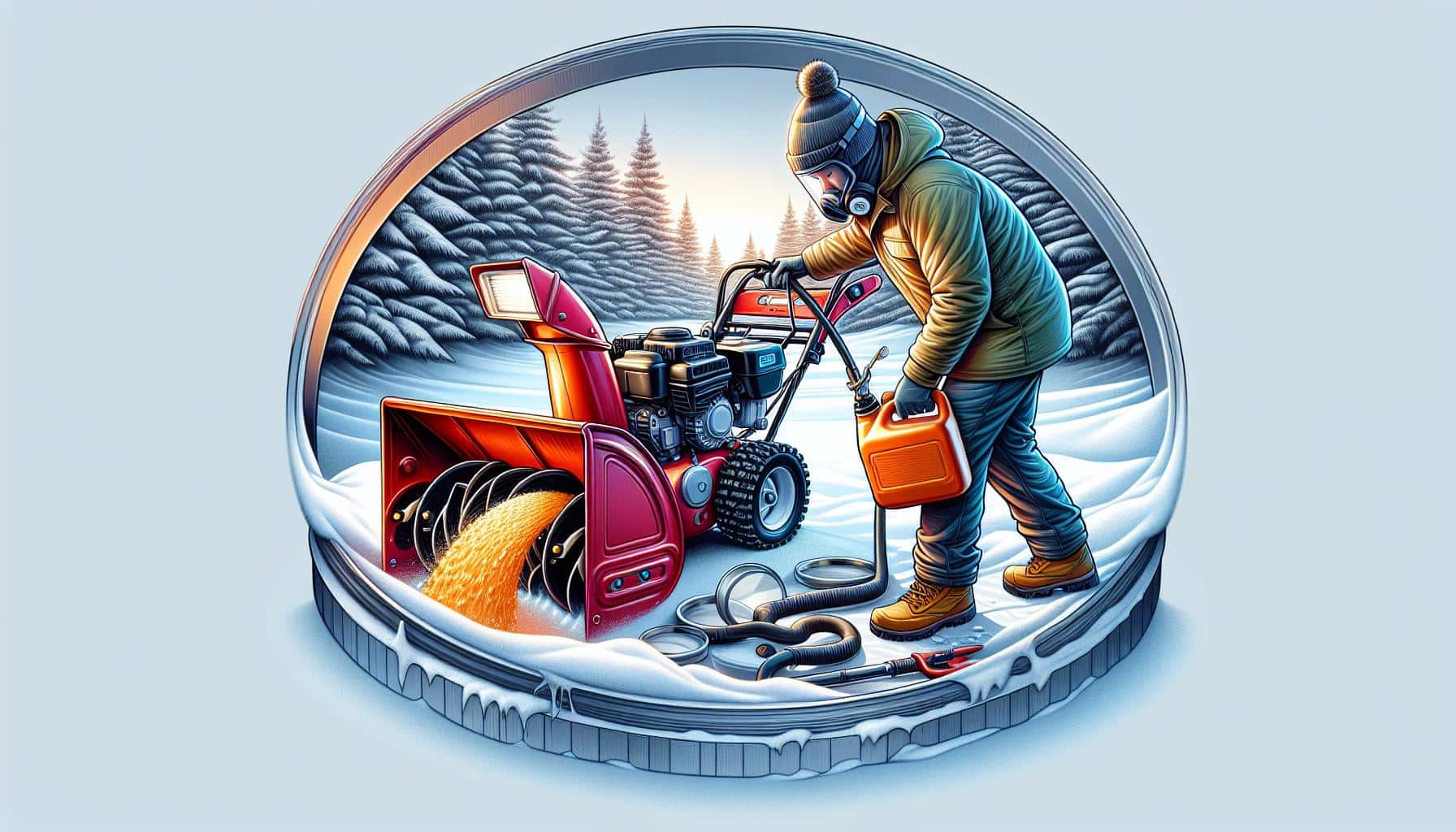
When winter’s over, it’s crucial to prep your snowblower for storage, and that includes draining the gas. Leftover fuel can deteriorate and harm your machine’s engine, leading to costly repairs. Whether you’ve got an electric model or a gas-fueled beast, knowing how to drain the petrol is essential for maintaining your snowblower’s longevity.
If you’re stumped on how to get started, don’t worry. Draining gas from your snowblower is simpler than you might think, even if your machine lacks a drain spout. With the right approach, you’ll ensure your snowblower’s ready to roar to life when the next winter season hits.
Why draining gas from a snowblower is important
Maintaining your snowblower involves more than simply cleaning it off after use. One of the most crucial steps is draining the gas at the end of the season, a procedure that safeguards against various potential issues.
Preventing Engine Damage
Ethanol-laden gas risks your snowblower’s engine health. When it sits idle, the ethanol can attract moisture, leading to corrosion and the gumming up of components. Clogged engines are troublesome; they often refuse to start and might necessitate a professional service, which can be costly.
Failure to drain the gas can result in:
- Corrosion within the engine
- The formation of engine-clogging varnish
- The need for potentially expensive engine repairs or clean-up
A neglected engine can swiftly transform from a reliable machine into a major headache. Regular gas draining is a preventive habit that keeps engine problems at bay and ensures your snowblower starts readily next winter.
Easy Maintenance
Draining the gas from your snowblower is straightforward. Unlike other more complicated machinery maintenance tasks, it requires no special skills or tools. You’ll appreciate the simplicity of the task:
- Put on your safety gear: Gloves, earplugs, and goggles.
- Ensure the engine is cool: This is to avoid any accidents if the engine has been recently used.
- Prepare your drainage container: Use a gas-safe container to catch the fuel.
- Siphon the fuel: Transfer as much as possible from the tank to your container.
Following the manual’s instructions makes the process manageable and something you can do without a trip to the shop. By conducting this simple maintenance yourself, you maintain your machine’s performance and avoid unnecessary costs.
Preparing for Storage
An empty tank is a happy tank when it comes to storage. To keep your snowblower in peak condition, it is vital to empty the tank before putting the machine away for the offseason. Gasoline left in the tank over the storage period can degrade and:
- Form sticky residues
- Settle into sludge that clogs the fuel lines
- Cause hard starting or poor running conditions when the snowblower is used again
By running the engine dry after draining the fuel, you’re minimizing the potential for these deposits to form. This step is essential for maintaining the machine’s lifespan and ensuring it will be ready and operational for the next snowy season.
Tools needed to drain gas from a snowblower

Maintaining your snowblower requires some basic tools to ensure the job is done efficiently and safely. Here’s what you’ll need:
Fuel Siphon
A siphon is crucial to remove fuel without mess or waste. Fuel Siphons are designed to transfer liquids quickly and can prevent spillage that could otherwise be hazardous. Your siphon pump should have a long enough reach to comfortably get from the fuel tank to your fuel container. Here’s why a siphon is necessary:
- Safety: Reduces risk of fuel spillage and fumes.
- Efficiency: Speeds up the draining process significantly.
- Ease of Use: Simple manual operation requiring minimal physical effort.
Container for Fuel
You’ll need an appropriate container to hold the gas once it’s siphoned out of the snowblower. Always use a container specifically designed for storing fuel. This is important because:
- Compliance: Meets safety regulations for fuel storage.
- Prevents Contamination: Preserves the quality of the fuel for future use or proper disposal.
- Durability: Made to withstand the properties of gasoline which can degrade other materials.
Safety Goggles
Protecting your eyes should never be an afterthought. Safety Goggles offer a barrier against possible splashes or vapours during the draining process. Keep in mind:
- Full Coverage: Ensures that no fuel can enter the eyes from any direction.
- Anti-Fog: Earlier versions of goggles would fog up during use. Modern safety goggles are designed to remain clear.
- Comfort: Modern goggles are adjustable and lightweight, increasing the likelihood of their use.
Gloves
Handling fuel and components of the snowblower can be harmful to your skin. Hence, gloves are an essential part of your toolkit. Gloves should be:
- Chemical Resistant: To prevent gasoline from soaking through to the skin.
- Durable: Thick enough to resist tearing but still allow for a good grip.
- Comfortable Fit: A good pair of gloves won’t impede your dexterity.
Remember, before starting this maintenance task, familiarise yourself with your snowblower’s manual for any model-specific instructions or warnings.
With these tools at hand, you’re set to maintain your snowblower’s performance and extend its lifespan. The correct equipment not only makes the job easier but also upholds safety standards that protect both you and your snowblower.
Steps to drain gas from a snowblower

Step 1: Prepare the Snowblower
Before you begin, ensure your snowblower is on a level surface and has cooled down to prevent any burns. It’s essential to disconnect the spark plug wire to eliminate the risk of accidental ignition. Safeguard your hands and eyes by wearing safety gloves and goggles, and don’t forget ear protection if you’re working in a noisy environment.
Step 2: Locate the Fuel Line and Shutoff Valve
Identify the fuel line, which is typically a small rubber hose connecting the gas tank to the engine. You’ll find it running along the underside or side of your snowblower’s gas tank. The shutoff valve, if your model has one, should be inline with the fuel hose and easily accessible.
Step 3: Position the Container
Place an approved fuel storage container below the fuel line. The container should be capable of holding at least the full volume of your snowblower’s gas tank to prevent any spills or overflow.
Step 4: Disconnect the Fuel Line
Using a suitable tool, like pliers or a screwdriver, loosen the clamp that secures the fuel line to the tank’s nipple. Be ready with a method to direct the fuel into your container; you can fashion a temporary tube from materials like aluminum foil if necessary.
Step 5: Drain the Gas
Carefully remove the fuel line from the tank’s nipple and allow the gas to flow into your container. The process should be carried out gently to minimize the risk of fuel splashing. If your snowblower has one, you can also use the fuel cut-off valve to control the flow.
Step 6: Close the Shutoff Valve
Once the gas is fully drained, close the shutoff valve to seal the gas tank. This step is crucial to prevent any contamination from entering the empty tank and preparing it for refueling when needed.
Step 7: Reconnect the Fuel Line
After draining, reattach the fuel line to the nipple and secure it with the clamp. Make sure the connection is tight to avoid any potential leaks. Double-check all connections for security before moving on to the next stage of maintenance or storage.
Tips for draining gas from a snowblower

Work in a Well-Ventilated Area
When you’re about to drain gas from your snowblower, your safety is paramount. It’s vital that you do this task outdoors, where there’s plenty of fresh air. Carbon monoxide fumes from running engines are hazardous, so ensure never to run the snowblower in a confined space. A well-ventilated area also helps in dispersing any flammable vapours, reducing the risk of ignition. Plus, natural light can assist you in seeing what you’re doing, making the job easier and possibly quicker.
Avoid Spilling Gas
To prevent any accidental spills, choose a flat, stable surface to work on. This stabilises the snowblower, mitigating the chance of it tipping over and causing a spill. If you’re using a siphon pump, insert the tube into the fuel tank as deep as possible to clear out as much gas as you can. Keep a catch pan ready next to the tank, placing the siphon’s other tube securely inside. Be prepared with rags or towels in case of spillage. Rigging a short length of hose over the tank’s nipple can efficiently guide fuel into your disposal container, minimizing mess and waste.
Dispose of the Old Fuel Safely
The last thing you want is to harm the environment or risk a fire hazard with improper disposal of fuel. The old gas should be stored in a suitable container, clearly labeled for hazardous waste. Many service stations or recycling centers offer facilities for safe disposal. Make sure the container is tightly sealed to avoid leaks and fumes escaping. Always keep old fuel away from any ignition sources until you can dispose of it properly. Remember, safety first – yours and the environment’s.
As you finish these steps, your snowblower should be ready for further maintenance or storage, free from old gasoline that could compromise its performance.
Conclusion
Draining the gas from your snowblower doesn’t have to be a challenging job. You’ve now got the know-how to do it efficiently and safely. Remember the importance of a well-ventilated space and the use of a siphon pump to prevent spills. With the old fuel properly disposed of, you’re ensuring your snowblower’s longevity and performance. Stick to these steps and you’ll have your machine prepped and ready for its next job or a well-earned rest.
Colin Macmillan is a seasoned entrepreneur and the CEO of Riverwood Landscape, a leading landscaping company based in Canada. He has been at the helm of the company since leaving high school, demonstrating his strong leadership skills and business acumen.
Colin’s expertise lies in various aspects of landscaping, including lawn care, interlocking, sod installation, and commercial maintenance. His hands-on approach and dedication to the craft have been instrumental in building Riverwood Landscape into a reputable brand.
One of his most notable achievements is the creation of a successful landscape franchise that services multiple locations. This accomplishment underscores his strategic thinking and ability to scale operations effectively.
Colin has also had the privilege of working with Guelph Hospital for landscaping and maintenance, a testament to the trust and reliability that his company has earned over the years.
His professional mission is to offer the best services and experiences for customers, a goal that he tirelessly pursues. Colin’s commitment to excellence and customer satisfaction continues to drive the growth and success of Riverwood Landscape.








